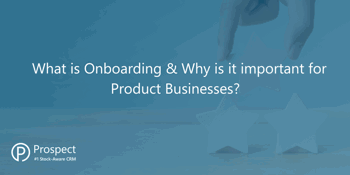
What is Onboarding & Why is it Important for Product Businesses?
Customer onboarding is largely associated with software businesses...but if you sell products business-to-business, a successful onboarding programme - turning one-time purchasers into loyal, long-term advocates - is crucial for your growth too.
Firstly, what is onboarding?
Onboarding, or customer onboarding, is the process of turning new customers (i.e. businesses that have purchased only once from you) into customers who order from you regularly (i.e. not just a one off purchase, but come back to buy from you frequently).

Why does it matter?
There are plenty of reasons why you should prioritise onboarding your customers, both in the short and long term. But, to keep it brief, we’ve rounded up our favourites...
Increased Profits & Lower CAC
It’s statistically proven that most revenue is generated by existing customers. In fact, according to Business.com, it can cost between 5 and 10 times more to acquire a new customer than sell to an existing one. Even if your customer acquisition cost (CAC) is relatively low, multiply that by the average number of new customers you need to attract, and it really starts to add up.
The key to successfully growing a profitable Wholesale, Distributor or Manufacturing business is not just to rely on attracting new customers and get them to place their (first) order with you, but to then successfully onboard them into becoming a regular, repeat customer. Take this example - you’re a Wholesaler selling coffee beans to coffee shops. Selling just x1 kilo bag of coffee beans likely won’t be profitable...you may be selling it at cost, or even at a loss (trust us, it’s pretty common!).
Retention = More Orders
If you could...
a) Know who your at-risk customers are, then
b) Keep hold of them for longer, encouraging them to place more orders with you
...then your acquisition cost soon drops. And, revenue increases.
Shiny new customers have found your product and have made a purchase. But in order to turn them into a loyal, long-term, profitable B2B relationship - and avoid them ditching you for your competitors - you must successfully onboard them. In short: customers who buy from you regularly are much less likely to churn.
Plus, a successful onboarding process will enable your business to increase customer lifetime value (LTV) too.
Champions > Public Referrals
Champions. Loyal customers. Evangelists. Happy customers. Your tribe. Whatever you refer to them as, they’re advocates of your products, meaning they’re perfect targets for public reviews/referrals, which you can then share with the world to attract more, like-minded customers that fit your ICP.
By encouraging customers to repeat purchase, you get more chances to turn them into advocates. Find out who they are, then draw up a process whereby you ask them for reviews and referrals. It may seem bold to just ask someone to give you a review, but phrased in the right way and they’ll be more than happy to do it.
And, according to Shipstation, product reviews have a positive knock-on effect to other stuff too (help you improve product descriptions, your SEO, etc.). Handy!
When is a customer "onboarded"?
It really depends on how your business operates, the average number of orders per customer, and a whole host of other things that should be calculated. But to give you a working example - we analysed a typical product-based business (they sell products from stock to other businesses) and studied their customer’s ordering behaviour. From this analysis, we identified that the average time between a customer’s first and second order was 30 days, with a relatively wide standard deviation of up to 52 days. And this declined fairly rapidly over the first five orders, with the average falling quickly and the standard deviation reducing too. It showed that this business’ customers don’t become a "settled, regular customer" until they’ve placed at least four to five orders.
Once a customer placed four to five orders, it became much more likely that they would place another order soon (within 14 days in this example) and then settle into a weekly or bi-weekly purchasing pattern. However, up to this point, they might have not ordered again for a month or even two, or indeed never, unless those first four orders are secured as a minimum.
How can I get my customers onboarded?
Chase Missing Orders
A good place to start is by getting your hands on a real-time list of all your customers that you’re missing orders from. These are quick wins. Ideally, Sales teams should be armed with insights on these customers (like expected order values, what date they should have placed an order by based on previous orders etc.), so they can prioritise this list and swiftly secure this business. As we know - more orders means you’re more likely to keep customers for longer!
Marketing Campaigns
Start up some targeted campaigns that go to the right people at the right time. For example:
- Win-back campaigns to at-risk (or churn-risk) customers: Make limited time offers, recommend products to them based on their past purchases, share some valuable resources and assets, recommend popular products at discount, send emails from Account Managers that look like 1-1 emails etc.
- Drip feed campaigns to onboard new customers: A nurture campaign for newbies will make sure you’re front of mind when they’re thinking about re-ordering products or ordering something different.
- Promote additional products to help upsell: Find out who has bought product X, but not Y, and initiate an upsell campaign to encourage greater purchase volume and increase average order values.
So - onboarding really isn’t just for software companies after all!
Struggling to identify who you’re missing orders from, who you’re at risk of losing, and who’s stopped buying completely? Try Prospect for free, then integrate your trial with your Inventory Management or Accounting system, and get this real-time analysis immediately!
Want to learn more? Watch our webinar with our CEO to learn why onboarding is a key part to RFM and the Growth Playbook for Wholesalers, Distributors and Manufacturers.
